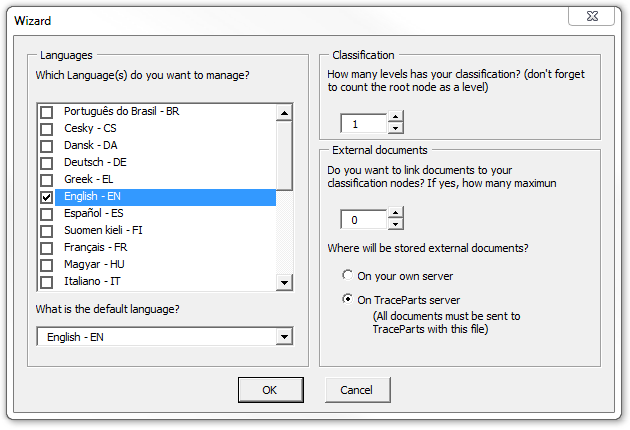The template file contains a small macro, designed to build the file structure that corresponds to your needs. To do so, it calls up a dialog box containing a number of questions for you to answer.

- Double-click the file to open it in Microsoft Excel.
- If an alert message appears about the macro, click the «Enable macros» button.
- Click the «Create the structure» button to run the macro.
- The following dialog box appears on the screen. (If not, it must be because you disabled the macros, in which case see the Microsoft Excel documentation on how to re-enable macros.)
[accordion style=»normal» open=»no»][accordion_toggle title=»Languages section»]
From the list, select the languages for which you want to supply data.
- You must select at least one language
- You may select more than one
- The language code for each selected language will be marked in the «System» tab next to an attribute called «Selected_Language_Code»
Depending on what you select, one or more tabs will be created – one tab per selected language.
These tabs are labeled «Classification» and are suffixed by a separator followed by a language code.
For example, if French and English are selected, the following tabs will be generated:
- «Classification_FR», into which you will enter the data for French;
- «Classification_EN», into which you will enter the data for English.
Next, in the pull-down menu underneath the list, you need to select the «default language»
- This is required information.
- The list of languages available in the pull-down menu depends directly on which languages were selected earlier.
- The language code that corresponds to your selection will be marked in the attribute «Default_Language_Code» in the «System» tab.
[/accordion_toggle][/accordion]
[accordion style=»normal» open=»no»][accordion_toggle title=»Classifications section»]
Specify here the number of levels in your classification.
Important: The name of your catalog must be interpreted as the starting level (Level 1). You need to factor this into the total number of levels in order to answer the question correctly.
- Depending on how you answer this question, a number of fields are created in each «Classification» tab:
- «Classification_Label_Level_x»
- «Classification_Description_Level_x»
where «x» is a digit ranging from «1» up to the declared number.
[/accordion_toggle][/accordion]
[accordion style=»normal» open=»no»][accordion_toggle title=»External documents section»]
If you have documents that relate to your branches of classification, such as notices explaining your product ranges, you can declare them in the template file.
Start by specifying the maximum number of documents that you want to associate with each node in your classification.
- We offer two ways of managing these documents:
- «Either you send us your documents, and we will host them on our server;»
- «Or, if your documents are already publicly accessible on your own server, simply send us the URL for each of the documents you want to reference.
If you don’t have any associated documents, leave the counter at zero; none of the above fields will be created.
Once you have answered all the questions, click «OK».
The macro then creates several tabs containing various fields.

The generated file structure is described below.
Once the file structure has been generated, the macro cannot be used again.
[/accordion_toggle][/accordion]


 English
English Deutsch
Deutsch Français
Français Italiano
Italiano Español
Español Português
Português 中文 (中国)
中文 (中国) 日本語
日本語